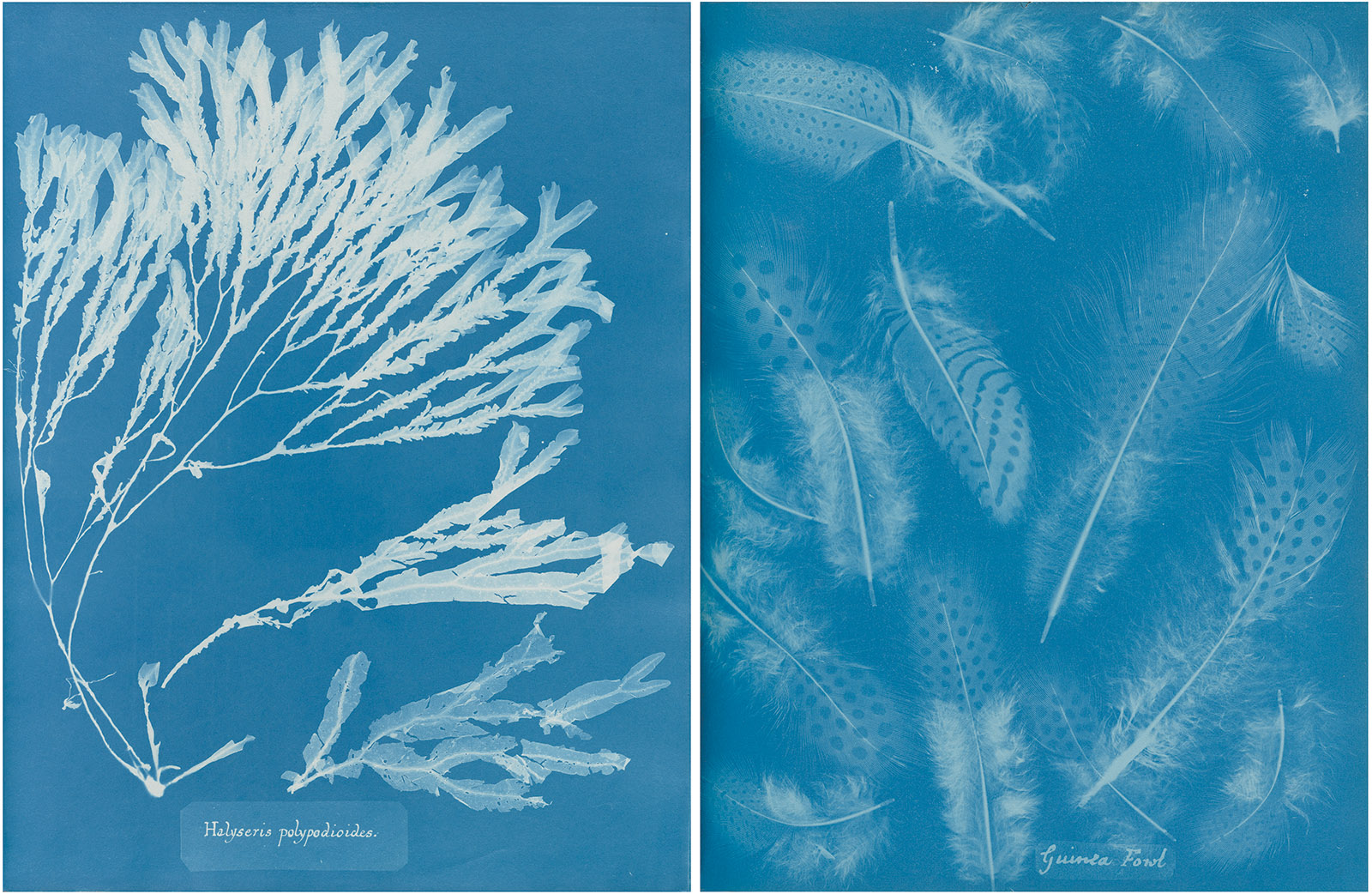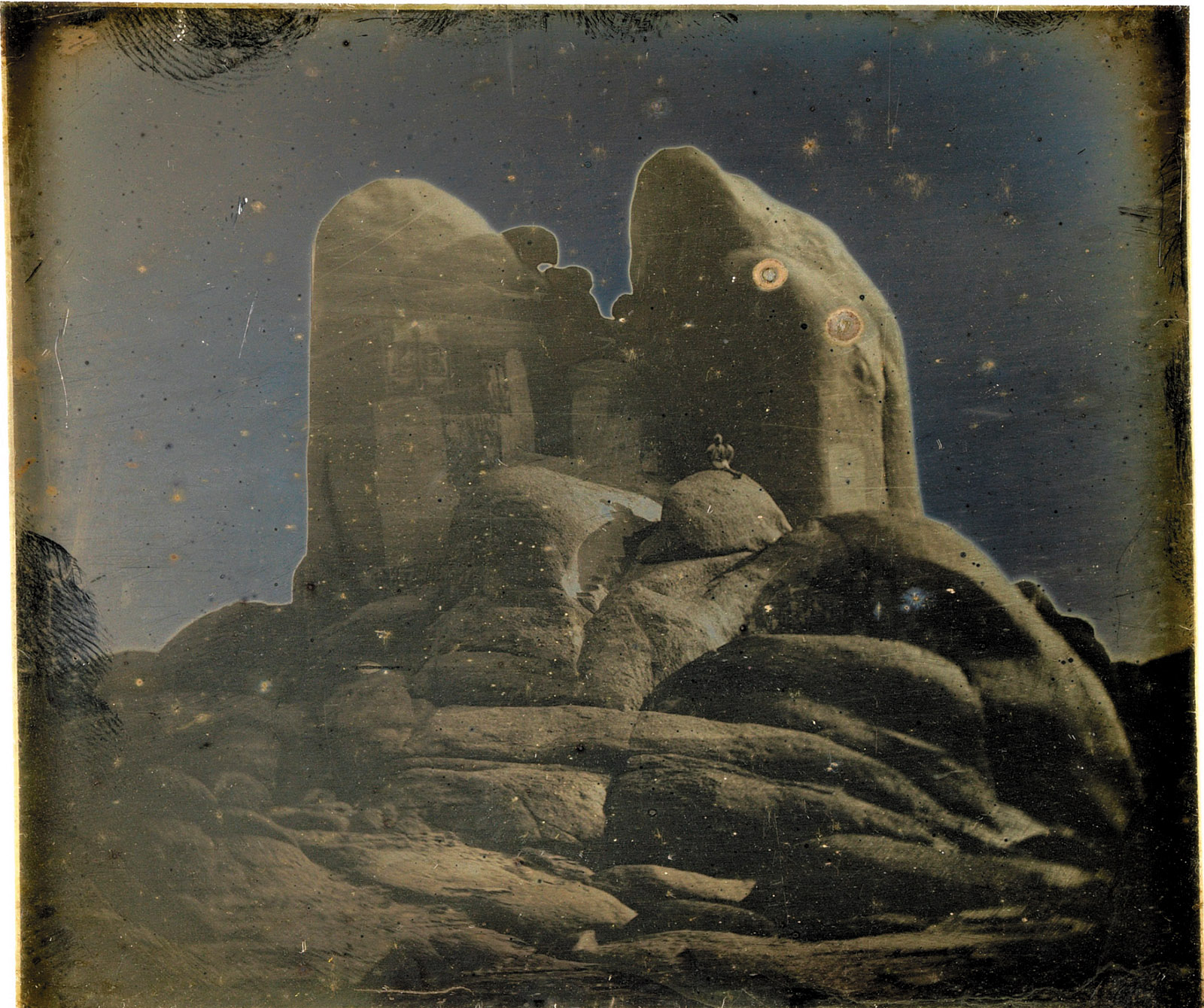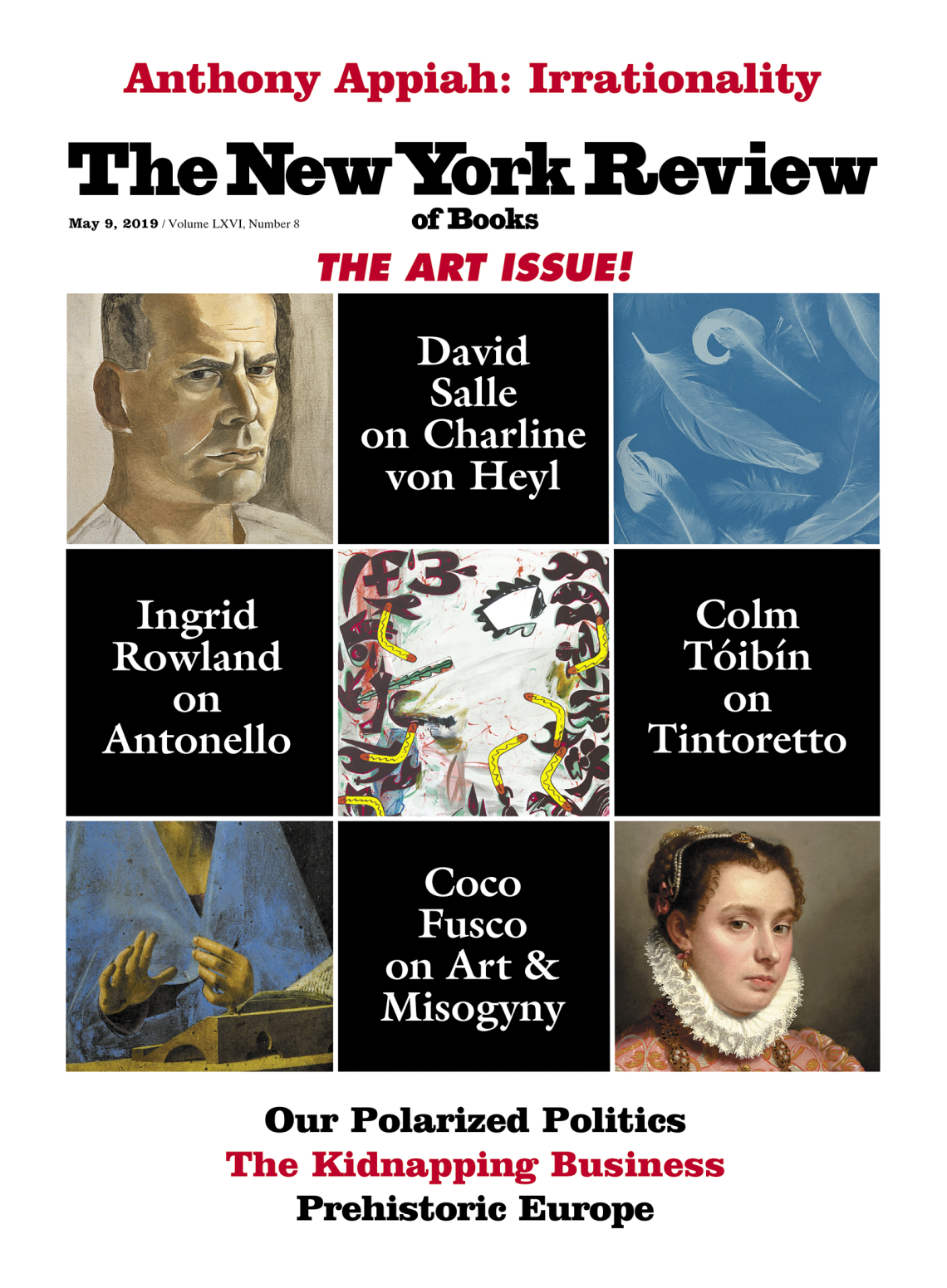
New York Public Library/Private Collection
Two cyanotypes by Anna Atkins: at left, Halyseris polypodioides, 10 1/4 x 8 inches, from her book Photographs of British Algae: Cyanotype Impressions, 1843–1853; at right, Guinea Fowl, 10 x 7 1/2 inches, from an album presented by Anne Dixon to Henry Dixon in 1861
Photography was invented in slow motion, over multiple decades, by a number of people working mostly independently and in many different forms. Thomas Wedgwood captured camera obscura images on chemically treated surfaces in 1802, although they darkened entirely when exposed to light. Nicéphore Niépce accomplished something similar in 1816, and about ten years later succeeded in photographing the view outside his window on a bitumen-coated pewter plate—the earliest surviving photograph. William Henry Fox Talbot made permanent photographs on salted paper as early as 1835, although he didn’t make his invention public until 1839; claims have been made for an even earlier success with paper photographs by Hippolyte Bayard.
By that time Louis Daguerre (who in 1829 had partnered with Niépce, who died in 1833) had announced his success in preserving images on a silver-plated copper sheet and further discovered that a latent image, initially invisible, could be chemically developed, drastically reducing exposure times. Daguerre’s process resulted in eerie, crystalline images of remarkable depth that could be viewed only at particular angles and in particular light conditions, and could not be reproduced. Fox Talbot’s smudgily evocative calotypes—a further evolution of his salted paper method that used silver iodide—seemingly more ephemeral, pointed the way to the future, although the terrain was still contested through the first decade of photography’s flowering.
In 1839 the English polymath John Herschel coined the term “photography” and discovered that hyposulphite of soda, or “hypo,” could be used as a medium for fixing photographic images permanently. In 1842 he invented the cyanotype process, a low-cost printing method that produced blue images as a result of a reaction of iron salts. This beautiful if relatively unstable process endured as a minority choice in photography until the early twentieth century; it lasted somewhat longer as a means for making architectural blueprints, and a few contemporary artists still use it today.
Very soon after Herschel’s invention, his friend Anna Atkins (1799–1871) began to use the cyanotype process for making photograms of algae, placing the vegetation directly on the cyanotype paper, under a sheet of glass, and exposing it to light. Atkins was using a camera by 1841 and may have been the first female photographer (unless that title belongs to Constance Fox Talbot, but no photographs made with a camera by either of them have survived). She certainly made the very first photographically illustrated book, Photographs of British Algae: Cyanotype Impressions, the first volume of which she issued in 1843, a year before William Henry Fox Talbot’s The Pencil of Nature. She selected the specimens (based on the nomenclature established by William Harvey in his Manual of British Algae, 1841), posed them, captured their images, made the prints, and stitched the fascicles herself, publishing a total of three volumes by 1853 that overall included fourteen pages of text (in her own handwriting) and some 425 plates. Only seventeen more-or-less complete copies are known to exist, some of which have emerged from private collections in recent years, so there may well be others. The New York Public Library owns Herschel’s copy, which was never bound, making it possible to exhibit individual pages in “Blue Prints,” a small, exquisite recent show devoted to Atkins, her work, and her correspondence.
Fox Talbot was making photograms in the mid-1830s and described the process in a paper he published in 1839. Atkins, a member of the London Botanical Society and an illustrator since her youth (notably for her father’s translation of Lamarck’s Genera of Shells in 1823), immediately grasped the possibilities of the new medium: its scientific exactitude, its reproducibility, its low cost. She also had an extraordinary eye. A great many people made photograms in the later nineteenth century but few were as vivid as Atkins’s (in addition to her book of algae, she produced at least two versions of an album of British and foreign ferns in the early 1850s).
In Sun Gardens, a thoroughgoing survey of Atkins’s work edited by Joshua Chuang (an expansion of Larry Schaaf’s book by the same title originally published in 1985), the range of algae in Atkins’s photograms is seemingly unlimited. The images explode with one unexpected shape after another: the ghostly, nearly transparent Nitophyllum gmelini; the svelte, shiny Enteromorpha intestinalis; the infinitesimally delicate Conferva fontinatis; Polysiphonia formosa looking like a clump of hair; Conferva crassa like loose threads; Ulva latissima like cellophane; Porphyra laciniata like an X-ray of a body part.
Of course, they all anticipate the X-ray, Wilhelm Röntgen’s 1895 invention, but even more strongly they anticipate what happened when early-twentieth-century artists like Christian Schad, Man Ray, and László Moholy-Nagy rescued the photogram from the placid Victorian album, which employed impressions of ferns as a decorative element with more than a suggestion of the funereal, and used it to represent light itself, in suspension, shaped around the litter of material culture—springs, scissors, combs, gears. The connection to later experiments is especially suggestive in Atkins’s work of the 1850s with flowering plants, also included in Sun Gardens. Here her specimens are larger and she frequently breaks the frame, which makes her prints look painterly, and she has a feeling for forceful diagonal compositions that cannot help looking Modernist to the much later eye. They are somehow both stark and lush in their unvarying blue and white. Clematis vitalba is a bewitching, expressionistic balance of spadelike opaque leaves and puffy, feathery clumps of flowers; Iris pseudacorus has flowers that look like positive images and leaves that look like strips of paper slashingly collaged against them.
Advertisement
Her plates of assorted feathers, meanwhile, resemble luxurious printed textiles, while the various title pages in her album of ferns look distinctly Victorian if somewhat more exuberant than the norm. Feathers and ferns connected Atkins to the decorative art of her own time; in her other work she was making art in the service of natural science, quite separate from contemporary aesthetic standards.
With the invention of photography came the realization that the whole world was waiting to be photographed. Where—apart from portraits, which were a given—to begin? Daguerre’s most notable daguerreotype is an 1838 view of the Boulevard du Temple in Paris that takes in a shoeshiner and his client standing still against a flow of traffic that is vaporized by the long exposure time. It did not at first inspire many other urban views; there are fewer than half a dozen surviving daguerreotype representations of New York City, despite the medium’s immediate popularity in the United States. Fox Talbot was more wide-ranging in The Pencil of Nature, which among its twenty-four plates includes photographs of Oxford, Paris, Lacock and Westminster Abbeys, a leaf, a haystack, a printed page, lace, china, fruit, and statuary. Yet the French took the lead in setting out to photograph the world systematically, beginning with its most notable cultural landmarks; in 1851, for example, the Commission des Monuments Historiques sent Bayard, Édouard Baldus, Gustave Le Grey, Henri Le Secq, and O. Mestral all over the country.
Other expeditions modeled their itineraries on aspects of the Grand Tour, such as Maxime Du Camp’s 1849–1851 travels through Egypt and the Near East, accompanied by his friend Gustave Flaubert, which he documented with 125 calotypes in his album Égypte, Nubie, Palestine et Syrie: dessins photographiques (1852). Several years earlier, Joseph-Philibert Girault de Prangey (1804–1892) had set himself an even greater task in covering the ancient world, not only because he took in Rome, Athens, and Asia Minor in addition to Du Camp’s itinerary, but also because he brought along a complete set of daguerreotype equipment and came back with something like a thousand plates. Girault, who had possibly been instructed in the medium by Daguerre himself, was a wealthy aristocrat who possessed few apparent material ambitions (except for decorating his house in Langres, which eventually became a grandly Orientalist showplace). He never published or displayed his photographs, instead using them as references for his watercolors, which he sent out into the world as a book of lithographs in 1851. It failed to sell, and the photographs were entirely forgotten until they were found in his house by a purchaser in 1920, after it had fallen into ruin. It wasn’t until 1998 that an exhibition was devoted to them at the Musées de Langres, and the Metropolitan Museum’s “Monumental Journey: The Daguerreotypes of Girault de Prangey” is his first full show in the US.
The photographs are anything but neutral documents intended as memoranda. Their array of formats is assertive by itself—six different sizes, including a 7 1/2" x 9 1/2" whole plate (a full inch per side larger than the standard Daguerre plate), a 7 1/2" x 7 1/2" square plate, and a long half plate—3 3/4" x 9 1/2"—uncannily suited to panoramas and towers. Girault often segmented his plates and took more than one picture, and didn’t cut the pieces apart afterward. His Street in Rosetta is divided into two long plates, on one half a street scene dominated by a minaret and on the other a dizzying palimpsest of walls and windows, densest at the top, with unaccountable shadows that somehow make it look like an aerial view. The additional staining and rubbing it has acquired over time make the two images look not unlike a 1960s Rauschenberg silkscreen.
Girault set off from Paris in February 1842, arrived in Rome two months later, and spent three months there, then six weeks in Athens and four months in Cairo. He clocked in at Constantinople, Smyrna, Damascus, and Baalbek, went back to Cairo and made it up the Nile as far as the first cataract, then was quarantined during an outbreak of plague in Alexandria. Once released he headed back north: Sidon, Tyre, Acre, Haifa, Jerusalem, Damascus, and Baalbek again, then Aleppo, getting back home early in 1845. His equipment alone weighed over a hundred pounds, and considering the number and weight of his wooden boxes of silver-plated copper sheets, he must have been followed at every step by a long train of porters (his travel logs remain missing). He photographed some of the people he met and perhaps employed, although the portraits seldom transcend their costuming (that also includes the French expatriates he met along the way).
Advertisement
Instead he was a great photographer of sculptural forms. These encompass structures, ruins, cityscapes, and trees—the subjects of his immensely powerful Cedars of Lebanon and his majestic Palm Tree Near the Church of Saint Theodore, Athens are exactly as imposing, finely wrought, and perhaps even as ancient as his Greek pillars and Egyptian minarets. The dimensions of his plates enhance his framing; he was seldom content with a conventionally composed view of a building (such as you find in, say, Du Camp, who floats everything in an abundance of air), but he is always concerned with matching the frame to the subject and can allow a fragmentary colonnade to dominate a picture that is cut to fit its dimensions. His verticals and his horizontals are equally acute, and he is as alert to the broader image (his Western Approach to the Acropolis, Athens is a dramatic, brooding view of noble rubble that could stand as the ruins of Earth) as he is to the fine grain of individual carvings (his Minaret and Dome, Khayrbak Mosque, Cairo displays seemingly every filigreed line).
The plates remained boxed but unglazed in his attic for a century, and this combination of preservation and decay imparts all sorts of unintended qualities that act as the visual stamp of time itself—the ghostly fading of the applied color, the effects that look like solarization, the skies artificially darkened near their tops. The pictures are particularly well displayed at the Met, in darkened vitrines where they seem to hover like tropical fish in an aquarium. Stephen C. Pinson’s thorough and extraordinarily well organized catalog, meanwhile, manages to do justice to the range of sizes and shapes and to convey their elusive surfaces without unduly cleaning them up.
Girault was an artist rather than a historian, an ethnologist, a geographer, or a journalist. His taste for ruins and his interest in Islamic cultures were both predicated on Romantic tendencies in those directions. He deplored the whitewashing of Cairo even as he was aware of its sanitary necessity, because it would destroy the city’s “couleur local si merveilleuse.” He was in every way a creature of his time, and yet he retained an open eye and an honesty about what he saw. He may have been drenched in preconceived notions, but his pictures do not suggest that they were bent or massaged to accord with an ideology. He preserved artifacts of the deep past as they stood in the more recent past, and, given how many have been destroyed or damaged in our own time (Baalbek, Aleppo, parts of Damascus and Jerusalem), his pictures are precious testimony in addition to being vigorous works of art.



